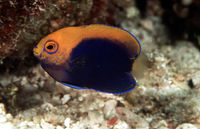Orangeback Angelfish (Centropyge acanthops)
From The Aquarium Wiki
Orangeback Angelfish
Centropyge acanthops
170 Litres (45 US G.)
5.1-7.6cm (2-3 ")
8.1 - 8.4
22.2-25.6°C (72 -78 °F)
8-12 °d
1:1 M:F
5-8 years
Family
Pomacanthidae
| You can contribute to the Aquarium Wiki by expanding this article. Dont be shy!. |
Contents
Additional names
- Fireball Angelfish, Orangeback Angelfish, Fireback Angelfish, African Pygmy Angelfish, African Flameback Angelfish
Additional scientific names
- Centropyge fisheri, Centropyges acanthops, Holacanthus acanthops, Xiphipops acanthops, Xiphipops fisheri, Xiphipops flavicauda
Origin[edit]
- Western Indian Ocean: Somalia to East London, South Africa. Also around oceanic islands. Common off East Africa.
Sexing[edit]
- Difficult to visually sex.
Tank compatibility[edit]
- A semi-aggressive Angelfish, should not be kept with delicate or shy creatures. May also nip at soft corals. Keep with robust similar-sized fish.
Diet[edit]
- This Angel should be fed a varied diet of marine algaes, spirulina, mysid shrimp and other foods such as high quality Angelfish pellet/flake foods.
Feeding regime[edit]
- Feed once or twice a day.
Environment specifics[edit]
- A spacious tank with plenty of hiding places and grazing provided with live rock is essential for this fish. Should only be introduced to mature tanks over 6 months old so these fish have plenty of grazing opportunities.
Behaviour[edit]
- An active fish that will spend its time looking for food around live rock and rubble.
Identification[edit]
- While the body is predominately blue, there is a broad, bright orange to yellow strip from the head along the back to the tip of the dorsal fin. The caudal fin is yellow and slightly transparent. Can be mistaken for Centropyge aurantonotus.
Pictures[edit]
External links[edit]
- Fishbase (Mirrors:
 )
)
